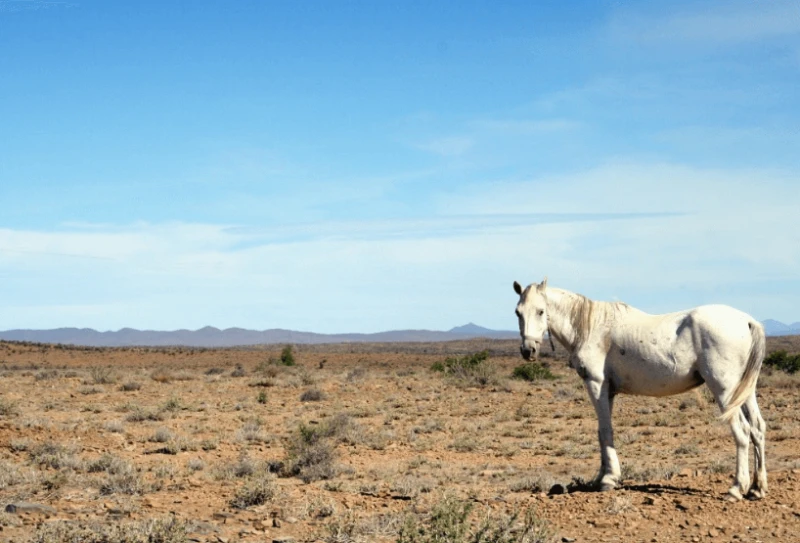From ‘lifeless dust’ to livestock farm: Farmer credits regenerative agriculture for soil transformation
From ‘lifeless dust’ to livestock farm: Farmer credits regenerative agriculture for soil transformation


In 2010, when Barry Meijer bought Meijer’s Rust near De Rust in the Klein Karoo, the soil was bare and depleted.
Nevertheless, he managed to produce a small crop of barley and oats each year on the 14ha he had under irrigation, while he restricted his cattle to the hills and mountains, where they primarily lived off spekboom.
About seven years ago, Meijer realised he needed an ‘intervention’ to improve the water-holding capacity of the soil:
“The soil was nothing more than dust. It was dead and compacted, resulting in poor water penetration and a lot of run-off.”
…
“I started reading as much as I could about regenerative agriculture and learnt the importance of building soil carbon to improve the soil structure, create a favourable habitat for soil organisms, and reduce input costs,” he says.
Meijer explains that regenerative agriculture is based on four production principles. The first is minimum disturbance of the soil.
“In the past, I used to plough the land to loosen and improve the water-holding capacity of the soil, but this exacerbated erosion problems and resulted in a lot of topsoil washing away. These days I use a Semeato no-till seeder to plant my cover crops.”
…
The second principle is to have living roots in the soil for as long as possible, while the third emphasises the importance of having as much diversity as possible through, for instance, planting of cover crops.
…
Fourthly, livestock are incorporated into the farming system to improve nutrient cycling through their excretions and movement across fields.
This is an excerpt. Read the original post here

 | Videos | More... |

Video: Nuclear energy will destroy us? Global warming is an existential threat? Chemicals are massacring bees? Donate to the Green Industrial Complex!
 | Bees & Pollinators | More... |

GLP podcast: Science journalism is a mess. Here’s how to fix it

Mosquito massacre: Can we safely tackle malaria with a CRISPR gene drive?

Are we facing an ‘Insect Apocalypse’ caused by ‘intensive, industrial’ farming and agricultural chemicals? The media say yes; Science says ‘no’
 | Infographics | More... |

Infographic: Global regulatory and health research agencies on whether glyphosate causes cancer
 | GMO FAQs | More... |

Why is there controversy over GMO foods but not GMO drugs?

How are GMOs labeled around the world?

How does genetic engineering differ from conventional breeding?
 | GLP Profiles | More... |

Alex Jones: Right-wing conspiracy theorist stokes fear of GMOs, pesticides to sell ‘health supplements’




 Viewpoint — Fact checking MAHA mythmakers: How wellness influencers and RFK, Jr. undermine American science and health
Viewpoint — Fact checking MAHA mythmakers: How wellness influencers and RFK, Jr. undermine American science and health Viewpoint: Video — Big Solar is gobbling up productive agricultural land and hurting farmers yet providing little energy or sustainabilty gains
Viewpoint: Video — Big Solar is gobbling up productive agricultural land and hurting farmers yet providing little energy or sustainabilty gains Fighting deforestation with CO2: Biotechnology breakthrough creates sustainable palm oil alternative for cosmetics
Fighting deforestation with CO2: Biotechnology breakthrough creates sustainable palm oil alternative for cosmetics Trust issues: What happens when therapists use ChatGPT?
Trust issues: What happens when therapists use ChatGPT? 30-year-old tomato line shows genetic resistance to devastating virus
30-year-old tomato line shows genetic resistance to devastating virus California, Washington, Oregon forge immunization alliance to safeguard vaccine access against federal undermining
California, Washington, Oregon forge immunization alliance to safeguard vaccine access against federal undermining The free-range chicken dilemma: Better for birds, but with substantial costs
The free-range chicken dilemma: Better for birds, but with substantial costs ‘You have to treat the brain first’: Rethinking chronic pain with Sanjay Gupta
‘You have to treat the brain first’: Rethinking chronic pain with Sanjay Gupta
